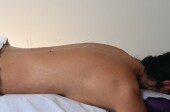- Double Mastectomy May Offer No Survival Benefit to Women With Breast Cancer
- Toxic Lead Found in Cinnamon Product, FDA Says
- Certain Abbott Blood Sugar Monitors May Give Incorrect Readings
- Athletes Can Expect High Ozone, Pollen Counts for Paris Olympics
- Fake Oxycontin Pills Widespread and Potentially Deadly: Report
- Shingles Vaccine Could Lower Dementia Risk
- Your Odds for Accidental Gun Death Rise Greatly in Certain States
- Kids From Poorer Families Less Likely to Survive Cancer
- Tough Workouts Won’t Trigger Cardiac Arrest in Folks With Long QT Syndrome
- At-Home Colon Cancer Test Can Save Lives
Steroid Shots May Not Help Back Pain


People who have lower back pain caused by spinal stenosis — a condition that narrows the open space in the spinal canal — are unlikely to get relief from steroid shots, a new study finds.
“Steroid injections are a common treatment for spinal stenosis, and we were surprised by the finding,” said lead author Dr. Janna Friedly, an assistant professor of rehabilitation medicine at the University of Washington in Seattle.
“These steroid injections aren’t helpful,” she said. “There is no added benefit to the steroid itself, so if people are considering these injections, I would recommend that they consider an alternative.”
Spinal stenosis causes pain by putting pressure on the spinal nerves. The condition is common in men and women over 60, according to the American Academy of Orthopaedic Surgeons.
Spinal stenosis is often treated with injections of local anesthetics plus steroids. More than 2 million of these injections are done each year among people on Medicare. Steroid injections are believed to relieve pain by reducing swelling and inflammation around the compressed spinal nerves, the researchers said.
Alternative treatments include exercise and surgery, Friedly said.
The new report was published July 3 in the New England Journal of Medicine.
Dr. Gunnar Andersson, a professor in the department of orthopedic surgery at Rush University Medical Center in Chicago and author of an accompanying journal editorial, is not ready to give up on steroid injections.
“It is helpful for some, and in others it has no effect or very short-term effects,” he said.
There are few treatments for spinal stenosis, Andersson said. “No treatment has been found to change the underlying problem or have a lasting effect on the stenosis,” he said.
Andersson can’t say who will benefit from steroid injections. “I tell my patients, ‘this is something you can try before resorting to surgery, but whether it’s going to help you or not, I can’t predict.’ “
The problem, Andersson said, is the overuse of steroid injections. “Many patients have been receiving many injections and for long periods of time, and that’s not justified,” he said.
Andersson said that if there is an improvement after one injection, another can be tried. “But beyond the second injection, you shouldn’t keep doing them,” he said.
For the study, Friedly and colleagues randomly assigned 400 people with back and leg pain caused by spinal stenosis to injections of either a local anesthetic (lidocaine) alone or in combination with steroids.
The drugs were injected into the outermost space of the spinal canal.
Symptoms improved initially in both groups, the researchers found. Three weeks after the injections, those who received the steroid said they had slightly less leg pain and slightly better function.
At six weeks, however, there were no significant differences between the two groups in either pain or function, Friedly’s team found.
Most people who got the steroid injection said they were satisfied with their treatment — 67 percent said they were “very” or “somewhat” satisfied, compared with 54 percent of those given lidocaine alone. Those given the steroid also showed improvement in symptoms of depression, the researchers added.
Friedly thinks the increased satisfaction reported may be due to early benefit seen in the first three weeks. Steroids are also known to improve mood and reduce fatigue. These effects may have contributed to feelings of satisfaction.
People given steroids, however, had lower levels of the hormone cortisol, a steroid made by the body. That suggests the whole body was using the steroid from the injection. The side effects of steroids include reduced bone mineral density, increased risk of bone fractures and weakening of the immune system.
These findings mirror those of another study published last year in the journal Spine. In that report, researchers found that older adults who get steroid injections for degeneration in their lower spine may fare worse than people who skip the treatment.
The researchers found that people who got steroid injections did see some pain relief over four years. But they did not fare as well as folks who went with other conservative treatments or with surgery right away.
And if people who got steroids eventually opted for surgery, they did not improve as much as people who had surgery, but who hadn’t had steroid shots.
More information
For more information on spinal stenosis, visit the American Academy of Orthopaedic Surgeons.
Source: HealthDay
Copyright © 2024 HealthDay. All rights reserved.










